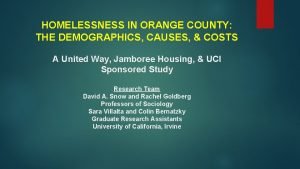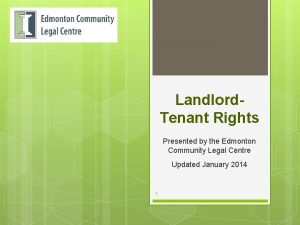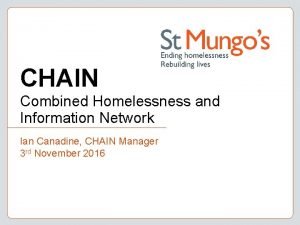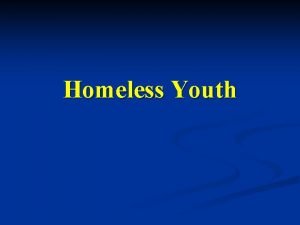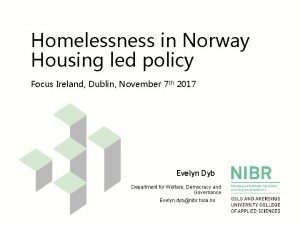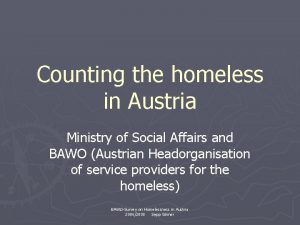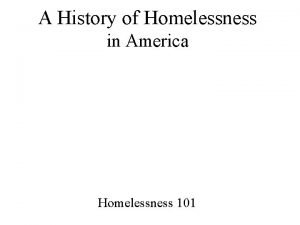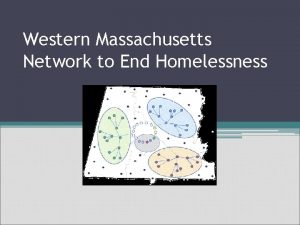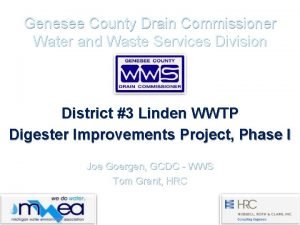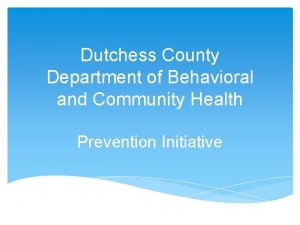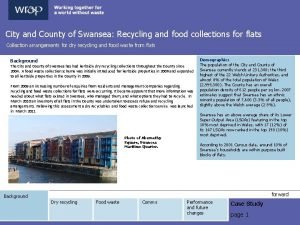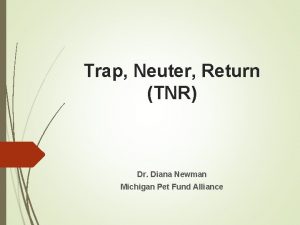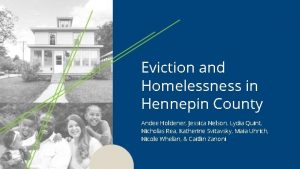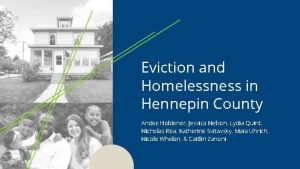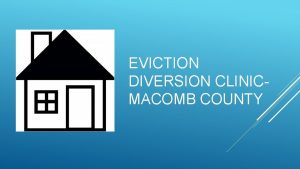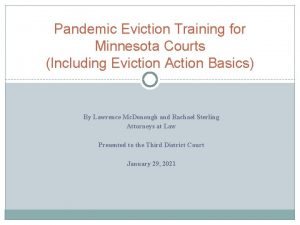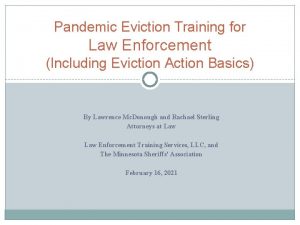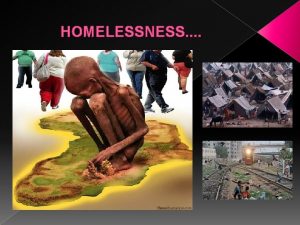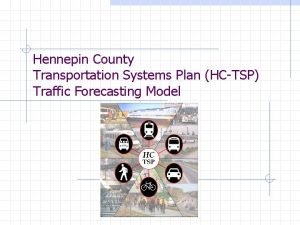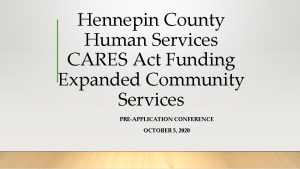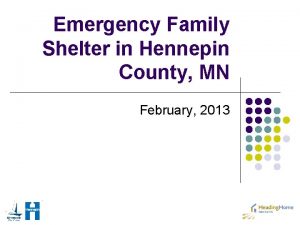Eviction and Homelessness in Hennepin County Andee Holdener









































- Slides: 41

Eviction and Homelessness in Hennepin County Andee Holdener, Jessica Nelson, Lydia Quint, Nicholas Rea, Katherine Svitavsky, Maia Uhrich, Nicole Whelan, & Caitlin Zanoni

Overview Background Interviews with prevention providers Analysis of Hennepin County data studying link between eviction and homelessness Policy implications Q&A

Interviews with Prevention Providers What resources are available to those at risk of eviction? Are people able to access resources in enough time to prevent eviction? Are there particular points in the system where people get stuck? Analysis of Hennepin County Data What is the risk of entering shelter if an individual has an eviction court record? What other factors contribute to shelter entry?

Interviews with Prevention Providers

Qualitative Methodology ● Semi-structured interviews ● 17 individuals from 12 different organizations across Hennepin County ● Involved in eviction/homelessness prevention work ● Convenience & snowball sampling ● Evaluative and descriptive coding

Other Nonprofit Orgs FHPAP Providers Financial Assistance Collaborative ns Programs Support Services Legal Services Hennepin County EA and EGA Churches and Religious Groups Legal Aid Resources ● ● ● Rent and/or mortgage payments Utility payments Deposit and application fees ● ● ● Case management Employment/income support Landlord communication and negotiation ● Tenant education and advocacy Representation in court ●

Common Themes in Interviews Eligibility Criteria can be Barriers Subjective Criteria of “Resolvability” Providers Networks and Relationships Cultural and Communication Barriers with Emergency Assistance ● Expedited Eviction Process Adds Pressure ● Timing and Limitations of Emergency Assistance Process ● ●

Eligibility criteria can be barriers It defeats the purpose — if you don’t have a job to maintain your property then how are you going to continue going forward and we wouldn't want to waste money in an area that we know that it’s not going to be beneficial. Although I hate not be able to help them, but it’s just what the program requires. ‘ ‘

Eligibilitycriteria can be barriers Our financial services are harder because we do need to have data for the funding streams…. We do need to have things like 30 -day income and the leases or the late letters — there’s a lot of paper trails with that. ‘ ‘

Eligibilitycriteria can be barriers By the time they get to us, that denial letter thing feels like a hoop to jump through because they know they’re not eligible, but they also know that in order to get our help that they have to get that. ‘ ‘

Subjective criteria of “resolvability” ‘ ‘ We do make decisions based on things like resolvability. If somebody is taking a lot of steps towards finding employment, they’re going to probably be someone we will work with again. If somebody doesn’t follow through on action plans from a previous request, they are less likely to receive as much assistance. It’s based on how you are working with us toward enabling your own stability as well.

Provider networks and relationships ● Providers leverage both formal and informal relationships to assist clients in obtaining aid ● Example: one provider knew a staff person at Hennepin County EA and could call them personally to expedite the EA denial process ● Other providers had established relationships with staff at other agencies and could quickly identify where to send a client

Culturaland communication barriers with EA I get why clients don’t want to go down there [to the County building]. They don’t feel treated with respect and I think the feeling is that they have to prove themselves; prove that they’re worthy, prove that they’re not lying, prove that they’re honorable. And having to do that when you’re already in a crisis is a huge burden that we’re asking people to go through. ‘ ‘

Expedited eviction process adds pressure Sometimes we are able to call the landlord and say “Hey look, we don’t want you to file. Can you wait? They’re applying at the county, the county isn’t going to pay, we will look at that. . . ” But we’re getting less able to do that. The more shortage of housing, the less the landlords are willing to work with us. ‘ ‘

Timing and Limitations of Emergency Assistance families specifically it almost always takes a full 30 days for them to process cases. That’s a really big frustration in that time frame when we’re working with them to facilitate that communication with their landlord. Sometimes doing contingent guarantees to say “If the county after 30 days says ‘No. ’ we will step in and help. ” It’s been a big frustration because a lot of landlords are filing ‘ ‘ There’s a lot of frustration with the county processes, because for much sooner than that period time frame, and they really don’t care if someone has a pending county case.

Timing and Limitations of Emergency Assistance Emergency assistance is really not “emergency reaction. ” It takes 28 days, it takes a long time, and they don't really get into it early enough. . . Tenants don't apply early enough, and we're sitting there many ‘ ‘ times, with the landlord saying: “Well, you said you applied. I need an answer. ”

FHPAP Providers System Dependency on EA/EGA Financial Assistance Other Nonprofit Orgs Hennepin County EA and EGA ● ● ● Churches and Religious Groups Collaborative ns Programs Rent and/or mortgage payments Utility payments Deposit and application fees

Qualitative Conclusions & Limitations ● Reached saturation of responses regarding eligibility, EA/EGA barriers, and the eviction prevention service network ● We were not able to interview front line workers in EA/EGA ● Selection bias ● Future research should include interviews with people seeking services, landlords, and religious organizations like churches, synagogues, and mosques

Eviction and Homelessness

Original Sample: Treatment Group 53, 712 12, 018

Unrestricted Treatment and Control Groups Treatment: Eviction records for matched individuals 26, 447 12, 018 Control: Random sample of county service use Control: Restricted by zip code Treatment Control


Propensity Score Matching Matched on demographics, program eligibility in last year, shelter use, and time Allows for more accurate comparisons between groups Restricted to 2009 -2014 6, 584 Treatment 6, 584 Control



Cox Hazard Model housing history social service use demographics

Three Models Single Adults Total Population Families






Over 10 times more likely to enter shelter with previous shelter stay

Other Findings African Americans and Native Americans had higher risks of shelter entry. 35. 9% higher risk for African Americans 89. 0% higher risk for Native Americans EA recipients in the past year (prior to eviction or program eligibility) 57. 3% higher risk Families with EA denials in the year before eviction or eligibility 22. 3% higher risk

EA Denial Findings Treatment Control 65. 1% Denied EA at least once 42. 8% Eligible for EA at least once 22. 3 percentage pts Eligibility-to denial Gap 4. 3% Received EA at least once 46. 5% Denied EA at least once 38. 8% Eligible for EA at least once 7. 7 percentage pts Eligibility-to-denial Gap 5. 2% Received EA at least once

FHPAP and EGA Findings Under 2% of both treatment and control group used FHPAP Emergency General Assistance eligibility is higher for the treatment group than the control group About 1. 7% of the treatment group and 0. 9% of the control group received EGA at least once

EA Denial Average time to EA denial Both groups Treatment Control Cases closed within 30 days ~68% 24 23

Limitations ● Sample represents less than a quarter of evictions filed in Hennepin County ● Limited to people who have interacted with county services ● Matches are done on the basis of name alone ● No information on zip codes included in sample ● Homelessness is narrowly defined ● Fluid family structure cannot be captured ● Gender is defined as a binary !

Quantitative Conclusions ● Higher risk between those with eviction filing and shelter entry, which further increases when coupled with an eviction judgment ● However, an eviction filing in Hennepin County results in a relatively low rate of shelter entry within the three years of the eviction disposition ● Little use of the homeless prevention programs due to high denial and low receipt rates ● Long EA process times leave individuals waiting weeks for a denial

Policy Implications ● EA/EGA eligibility and application process ● Examine personal experiences ● Coordinated prevention and prioritization ● Data Collection

Questions?
 Hennepin county emergency management
Hennepin county emergency management Hennepin county infectious disease manual
Hennepin county infectious disease manual Causes of homelessness orange county
Causes of homelessness orange county Constructive eviction definition
Constructive eviction definition Kansas eviction prevention program
Kansas eviction prevention program Landlord harassment alberta
Landlord harassment alberta Eviction diversion program richmond va
Eviction diversion program richmond va Chain homelessness
Chain homelessness Finland homelessness solution
Finland homelessness solution Homelessness
Homelessness Definition of youth homelessness
Definition of youth homelessness Michigan campaign to end homelessness
Michigan campaign to end homelessness Abolish homelessness
Abolish homelessness Homelessness in norway
Homelessness in norway Homelessness in austria
Homelessness in austria Timeline of homelessness in america
Timeline of homelessness in america Definition of youth homelessness
Definition of youth homelessness The bill homelessness was
The bill homelessness was Triangle outcome star
Triangle outcome star Homelessness leadership council
Homelessness leadership council Housing options bristol
Housing options bristol Wakulla rec park football
Wakulla rec park football St mary's county land use and growth management
St mary's county land use and growth management San luis obispo building department
San luis obispo building department Howard county gifted and talented
Howard county gifted and talented Health and human services milwaukee
Health and human services milwaukee Genesee county water and waste
Genesee county water and waste Dutchess county behavioral and community health
Dutchess county behavioral and community health Orange county towing and transportation
Orange county towing and transportation Volusia county permit center
Volusia county permit center Lorain county child services
Lorain county child services Howard county gifted and talented
Howard county gifted and talented Wood recycling swansea
Wood recycling swansea Dane county aging and disability resource center
Dane county aging and disability resource center Eaton county spay and neuter
Eaton county spay and neuter Lewis and clark county montana
Lewis and clark county montana Miami dade eco adventures
Miami dade eco adventures Delaware county adult protective services
Delaware county adult protective services Centre county drug and alcohol
Centre county drug and alcohol Orange county arts and cultural affairs
Orange county arts and cultural affairs Jessamine county parks and rec
Jessamine county parks and rec Volusia county water department
Volusia county water department


